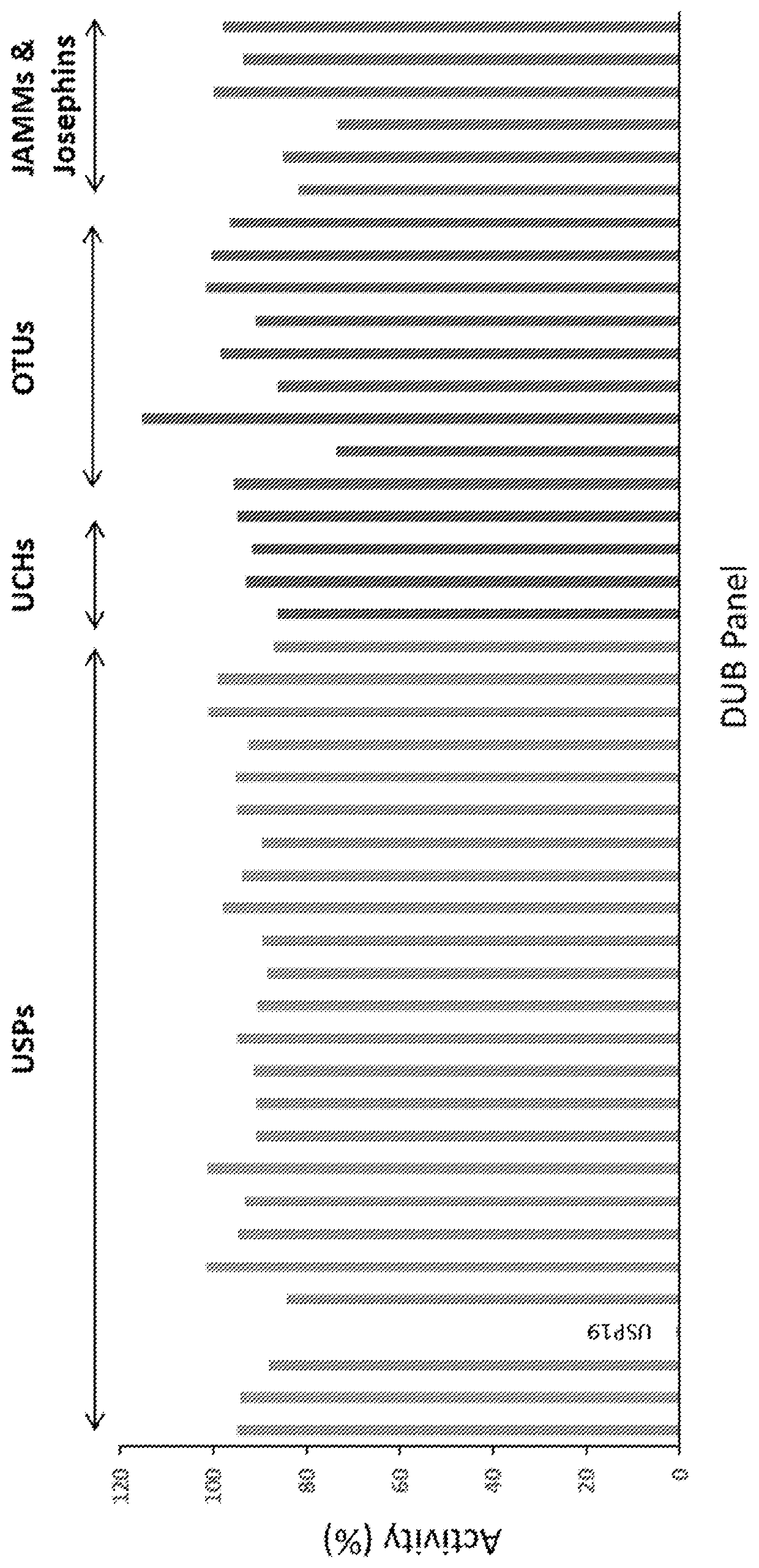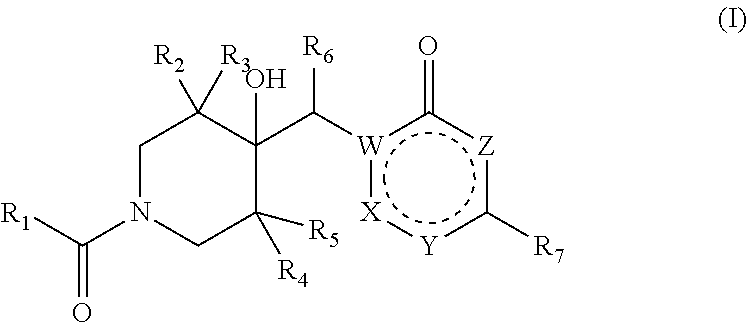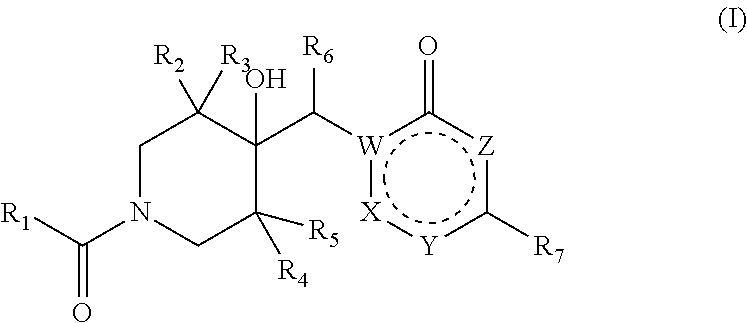Pharmaceutical compounds
a technology of ubiquitin and protease 19, which is applied in the field of pharmaceutical compounds, can solve the problems of increasing morbidity and mortality of cancer patients, severely limited clinical utility, etc., and achieves the effects of promoting antiviral immune response, treating or preventing muscular atrophy, and preventing muscular atrophy
- Summary
- Abstract
- Description
- Claims
- Application Information
AI Technical Summary
Benefits of technology
Problems solved by technology
Method used
Image
Examples
example 1
mo-1-((4-hydroxy-1-(3-phenylbutanoyl)piperidin-4-yl)methyl)-4-phenylpyridin-2(1H)-one
[0692]
Step 1: 5-Bromo-4-phenylpyridin-2(1H)-one
[0693]5-Bromo-2-chloro-4-phenylpyridine (1.13 g, 4.21 mmol) (prepared as described in Eur. J. Org. Chem., 2013, p 2316-2324) was dissolved in DMSO (14 mL) and a solution of sodium hydroxide (1.18 g, 29.5 mmol) in water (14.0 mL) was added. The mixture was heated in a microwave at 130° C. for 30 min. The mixture was acidified using 2 M HCl and extracted with EtOAc (×3). The combined organic extracts were washed with 1:1 water / brine, dried over MgSO4, filtered and concentrated. The residue was taken up in a small volume of DCM and the solid precipitate was collected by filtration through a sintered funnel. The crude product was washed with diethyl ether and dried to give the title compound (0.60 g, 57%). LCMS (Method B): RT=0.91 min, m / z=250, 252 [M+H]+.
Step 2: (R)-5-Bromo-1-((4-hydroxy-1-(3-phenylbutanoyl)piperidin-4-yl)methyl)-4-phenylpyridin-2(1H)-one
[...
example 2
rophenyl)-3-((4-hydroxy-1-(3-phenylpropanoyl)piperidin-4-yl)methyl)pyrimidin-4(3H)-one
[0695]
[0696]Prepared according to General Procedure 2 using Amine 1 (45 mg, 0.132 mmol), 3-phenylpropanoyl chloride (27.5 mg, 0.163 mmol), DIPEA (52 μL, 0.297 mmol) and DCM (3 mL) to give the title compound (48.4 mg, 84%). LCMS (Method B): RT=1.10 min, m / z=436 [M+H]+. 1H NMR (400 MHz, CDCl3): δ 8.12 (s, 1H), 8.08-8.03 (m, 1H), 7.46-7.44 (m, 1H), 7.32-7.15 (m, 7H), 7.10 (s, 1H), 4.47-4.40 (m, 1H), 4.05-3.92 (m, 2H), 3.87 (s, 1H), 3.65-3.58 (m, 1H), 3.40-3.31 (m, 1H), 3.04-2.96 (m, 3H), 2.66-2.61 (m, 2H), 1.51-1.23 (m, 4H).
example 3
Cyclobutylpropanoyl)-4-hydroxypiperidin-4-yl)methyl)-6-(2-fluorophenyl)pyrimidin-4(3H)-one
[0697]
[0698]Amine 1 (30 mg, 0.088 mmol), 3-cyclobutylpropanoic acid (12.7 mg, 0.099 mmol) and triethylamine (17 μL, 0.119 mmol) were dissolved in DMF and EDC (20.9 mg, 0.109 mmol) was added. The mixture was stirred overnight then partitioned between DCM and a mixture of brine and saturated aqueous sodium bicarbonate. The aqueous layer was extracted with DCM and the combined organic extracts were dried over MgSO4 and concentrated. The residue was purified by flash chromatography (GraceResolv 4 g, 10-90% EtOAc in cyclohexane) to give the title compound (24.1 mg, 66%). LCMS (Method B): RT=1.13 min, m / z=414 [M+H]+. 1H NMR (400 MHz, CDCl3): δ 8.17 (m, 1H), 8.08-8.03 (m, 1H), 7.48-7.42 (m, 1H), 7.30-7.24 (m, 1H), 7.20-7.14 (m, 1H), 7.12 (s, 1H), 4.45-4.38 (m, 1H), 4.18-4.12 (m, 1H), 3.99-3.93 (m, 1H), 3.81 (s, 1H), 3.73-3.65 (m, 1H), 3.48-3.39 (m, 1H), 3.10-3.01 (m, 1H), 2.31-2.19 (m, 3H), 2.09-2.00 ...
PUM
| Property | Measurement | Unit |
|---|---|---|
| pressures | aaaaa | aaaaa |
| temperature | aaaaa | aaaaa |
| temperature | aaaaa | aaaaa |
Abstract
Description
Claims
Application Information
 Login to View More
Login to View More - R&D
- Intellectual Property
- Life Sciences
- Materials
- Tech Scout
- Unparalleled Data Quality
- Higher Quality Content
- 60% Fewer Hallucinations
Browse by: Latest US Patents, China's latest patents, Technical Efficacy Thesaurus, Application Domain, Technology Topic, Popular Technical Reports.
© 2025 PatSnap. All rights reserved.Legal|Privacy policy|Modern Slavery Act Transparency Statement|Sitemap|About US| Contact US: help@patsnap.com



